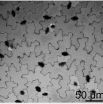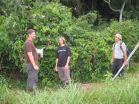(Press-News.org) Researchers at Virginia Tech and the Massachusetts Institute of Technology have used a computer-aided design tool to create genetic languages to guide the design of biological systems.
Known as GenoCAD, the open-source software was developed by researchers at the Virginia Bioinformatics Institute at Virginia Tech to help synthetic biologists capture biological rules to engineer organisms that produce useful products or health-care solutions from inexpensive, renewable materials.
GenoCAD helps researchers in the design of protein expression vectors, artificial gene networks, and other genetic constructs, essentially combining engineering approaches with biology.
Synthetic biologists have an increasingly large library of naturally derived and synthetic parts at their disposal to design and build living systems. These parts are the words of a DNA language and the "grammar" a set of design rules governing the language.
It has to be expressive enough to allow scientists to generate a broad range of constructs, but it has to be focused enough to limit the possibilities of designing faulty constructs.
MIT's Oliver Purcell, a postdoctoral associate, and Timothy Lu, an associate professor in the Department of Electrical Engineering and Computer Science, have developed a language detailed in ACS Synthetic Biology describing how to design a broad range of synthetic transcription factors for animals, plants, and other organisms with cells that contain a nucleus.
Meanwhile, Sakiko Okumoto, an assistant professor of plant pathology, physiology, and weed science at the Virginia Tech College of Agriculture and Life Sciences, and Amanda Wilson, a software engineer with the Synthetic Biology Group at the Virginia Bioinformatics Institute, developed a language describing design rules for expressing genes in the chloroplast of microalgae Their work was published in the Jan. 15 issue of Bioinformatics.
"Just like software engineers need different languages like HTML, SQL, or Java to develop different kinds of software applications, synthetic biologists need languages for different biological applications," said Jean Peccoud, an associate professor at the Virginia Bioinformatics Institute, and principal investigator of the GenoCAD project. "From its inception, we envisioned GenoCAD as a framework allowing users to capture their expertise of a particular domain in languages that they could use themselves or share with others."
The researchers said encapsulating current knowledge by defining standards will become increasingly important as the number and complexity of components engineered by synthetic biologists increases.
They propose that grammars are a first step toward the standardization of a broad range of synthetic genetic parts that could be combined to develop innovative products.
"Developing a grammar in GenoCAD is a little like writing a review paper," Purcell said. "You start with the headings and you progressively dig deeper in the details. At the end of the process, you have a much better appreciation for what you know and what you don't know about a particular domain."
Lu added, "Our group has a recognized expertise in synthetic transcription factors. We hope that this work will help a broad range of scientists use our results in their own projects."
"GenoCAD exemplifies the kind of cyberinfrastructure the institute is known for," said Dennis Dean, the director of the Virginia Bioinformatics Institute. "This type of portal can enable collaborations across disciplines and institutions to foster a team approach to today's most pressing scientific challenges."
Peccoud is chief scientific officer of GenoFAB LLC, a company providing products and services derived from GenoCAD.
INFORMATION:
More resources are available on the VT News website.
Bioscientists develop 'grammar' to design useful synthetic living systems
Researchers use software developed at Virginia Tech to design synthetic living systems
2014-03-13
ELSE PRESS RELEASES FROM THIS DATE:
Fish species unique to Hawaii dominate deep coral reefs in Northwestern Hawaiian Islands
2014-03-13
Deep coral reefs in Papahanaumokuakea Marine National Monument (PMNM) may contain the highest percentage of fish species found nowhere else on Earth, according to a study by NOAA scientists published in the Bulletin of Marine Science. Part of the largest protected area in the United States, the islands, atolls and submerged habitats of the Northwestern Hawaiian Islands (NWHI) harbor unprecedented levels of biological diversity, underscoring the value in protecting this area, scientists said.
Hawaii is known for its high abundance of endemic species – that is, species ...
Plant biology discovery furthers scientists' understanding of plant growth and development
2014-03-13
RIVERSIDE, Calif. — Auxin, a small molecule, is a plant hormone discovered by Charles Darwin about 100 years ago. Over the years that followed it became understood to be the most important and versatile plant hormone controlling nearly all aspects of plant growth and development, such as bending of shoots toward the source of light (as discovered by Darwin), formation of new leaves, flowers, and roots, growth of roots, and gravity-oriented growth. Just how a small molecule like auxin could play such a pivotal role in plants baffled plant biologists for decades.
Then, ...
Mid-level solar flare seen by NASA's SDO
2014-03-13
The sun emitted a mid-level solar flare, peaking at 6:34 p.m. EDT on March 12, 2014, and NASA's Solar Dynamics Observatory, or SDO, captured an image of it. Solar flares are powerful bursts of radiation. Harmful radiation from a flare cannot pass through Earth's atmosphere to physically affect humans on the ground, however -- when intense enough -- they can disturb the atmosphere in the layer where GPS and communications signals travel.
To see how this event may impact Earth, please visit NOAA's Space Weather Prediction Center at http://spaceweather.gov, the U.S. government's ...
Halting immune response could save brain cells after stroke
2014-03-13
MADISON — A new study in animals shows that using a compound to block the body's immune response greatly reduces disability after a stroke.
The study by scientists from the University of Wisconsin School of Medicine and Public Health also showed that particular immune cells – CD4+ T-cells produce a mediator, called interleukin (IL) -21 that can cause further damage in stroke tissue. Moreover, normal mice, ordinarily killed or disabled by an ischemic stroke, were given a shot of a compound that blocks the action of IL-21. Brain scans and brain sections showed that the ...
Condon publishes new research in Science
2014-03-13
A wasp's sting might explain it all.
Marty Condon, professor of biology at Cornell College, has been studying flies in the tropics for years, and in a paper published in Science this week, she reports evidence that there is more to a fly's ecological niche than where it lives and what it eats—you have to look at what eats the fly, as well.
In a previous Science paper, Condon and her co-researchers found that there were far more species of flies feeding on tropical flowers than expected. It was counter-intuitive, Condon said, to see so many species of flies filling what ...
Scripps Florida scientists devise new, lower cost method to create more usable fuels
2014-03-13
JUPITER, FL – March 13, 2014 – As the United States continues to lead the world in the production of natural gas, scientists from the Florida campus of The Scripps Research Institute (TSRI) have devised a new and more efficient method with the potential to convert the major components found in natural gas into useable fuels and chemicals—opening the door to cheaper, more abundant energy and materials with much lower emissions.
The research, which was led by TSRI Professor Roy Periana, uses clever chemistry and nontraditional materials to turn natural gas into liquid ...
Scripps Research Institute scientists discover a better way to make unnatural amino acids
2014-03-13
LA JOLLA, CA—March 13, 2014—Chemists at The Scripps Research Institute (TSRI) have devised a greatly improved technique for making amino acids not found in nature. These "unnatural" amino acids traditionally have been very difficult to synthesize, but are sought after by the pharmaceutical industry for their potential medical uses.
"This new technique offers a very quick way to prepare unnatural amino acids, many of which are drug candidates or building blocks for peptide drugs," said Jin-Quan Yu, a professor in TSRI's Department of Chemistry.
Yu's team has reported ...
Scientists find new way to upgrade natural gas
2014-03-13
America's current energy boom may take a new direction thanks to the discovery of a new way to turn raw natural gas into upgraded liquid alcohol fuel.
In the March 14 issue of Science magazine, chemists from Brigham Young University and The Scripps Research Institute detail a process that could reduce dependence on petroleum.
The most unexpected breakthrough in the paper was that ordinary "main group" metals like thallium and lead can trigger the conversion of natural gas to liquid alcohol. The research teams saw in experiments that natural gas to alcohol conversion ...
Stumbling fruit flies lead scientists to discover gene essential to sensing joint position
2014-03-13
LA JOLLA, CA—March 13, 2014—Scientists at The Scripps Research Institute (TSRI) have discovered an important mechanism underlying sensory feedback that guides balance and limb movements.
The finding, which the TSRI team uncovered in fruit flies, centers on a gene and a type of nerve cell required for detection of leg-joint angles. "These cells resemble human nerve cells that innervate joints," said team leader Professor Boaz Cook, who is an assistant professor at TSRI, "and they encode joint-angle information in the same way."
If the findings can be fully replicated ...
A novel battleground for plant-pathogen interactions
2014-03-13
Scientists at The Sainsbury Laboratory in Norwich, with collaborators at Michigan State University and the University of Illinois, have unveiled a new way in which plants perceive pathogens to activate immunity.
They also show how pathogens inhibit the mechanism to cause disease. It was previously only associated with other processes in mammalian cells.
When plants detect microbial molecules, they trigger immune responses to prevent disease. Although several plant immune receptors for these microbial molecules are known, how they are activated once the microbe is recognised ...
LAST 30 PRESS RELEASES:
Penn researchers awarded $25M to conduct trial using smartphones to fight heart disease
PCORI awards funding for new patient-centered healthcare research
Exploring the origins of the universe: 145 low-noise amplifiers complete ALMA telescopes
Empress cicada wings help illuminate molecular structure
Using sound waves to detect helium
Time burden in patients with metastatic breast and ovarian cancer from clinic and home demands
Researchers discover bias in AI models that analyze pathology samples
Scientists ID potential way to prevent brain injuries from triggering Alzheimer's
MASTER 2nd Open Call: Execution period kick-off
Algae for health in food and pharma
Advanced microrobots driven by acoustic and magnetic fields for biomedical applications
Chicago health information leader recognized for raising CPR readiness and blood pressure awareness
The Intimate Animal, a new book from Kinsey Institute Executive Director Dr. Justin Garcia
When blue-collar workers lose union protection, they try self-employment
New video dataset to advance AI for health care
MEA-based graph deviation network for early autism syndrome signatures in human forebrain organoids
New modeling approach sheds light on rare gut disease
Study documents potentially hazardous flame retardants in firefighter gear
Can certain bacteria regulate aging of the immune system and its related alterations?
AI model helps diagnose often undetected heart disease from simple EKG
There are fewer online trolls than people think
Cell membrane fluctuations produce electricity
Jeonbuk National University study shows positive parenting can protect adolescents against self-harm
Surface-engineered ZnO nanocrystals to tackle perfluoroalkyl substance contamination
This new understanding of T cell receptors may improve cancer immunotherapies
A new fossil face sheds light on early migrations of ancient human ancestor
A new immunotherapy approach could work for many types of cancer
A new way to diagnose deadly lung infections and save lives
40 percent of MRI signals do not correspond to actual brain activity
How brain-inspired algorithms could drive down AI energy costs
[Press-News.org] Bioscientists develop 'grammar' to design useful synthetic living systemsResearchers use software developed at Virginia Tech to design synthetic living systems






